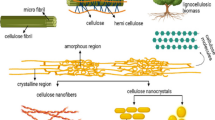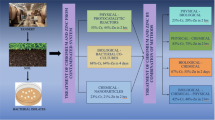Abstract
With the rapid development in nanotechnology, the preparation of novel self-assembled nanoscale composite materials and their numerous environmental applications have become a promising area of research among the environmental scientists. In view of above, the present study aims at fabrication of a mesoporous nanoscale material of calcium ferrite-zirconium oxide-magnetic nanocomposite (CF-ZrO-MNC) to explore its application in adsorption-driven remediation process of tetracycline (TC). The characterisation study of the so-prepared CF-ZrO-MNC has revealed the presence of 0.1213 cc/g of mesoporous volume with a specific surface area of 95.32 m2/g. A comparative study performed between CF-ZrO-MNC, CaFe2O4 and ZrO2 nanoparticles has proven the superior adsorption capability of CF-ZrO-MNC for TC over the pure phases of parent CaFe2O4 and ZrO2 nanoparticles. The optimisation of TC adsorption process was performed by response surface methodology, which has revealed that 98.14% of TC removal can be obtained within 60 min of contact time using 4.0 g/L of CF-ZrO-MNC dose with 40.0 mg/L of TC concentration at solution pH 6.0. The kinetic and isotherm studies have presented pseudo-second-order kinetic and Freundlich isotherm model as the best-fitted models, respectively. The results of Langmuir isotherm model fitting indicated that CF-ZrO-MNC poses 92.59 mg/g of maximum TC adsorption capacity which has been proven to be highly effective as compared to previously reported adsorbents for the remediation of TC from aqueous media.








Similar content being viewed by others
References
Daghrir, R.; Drogui, P.: Tetracycline antibiotics in the environment: a review. Environ. Chem. Lett. 11, 209–227 (2013)
Ravikumar, K.V.G.; Kubendiran, H.; Ramesh, K.; Rani, S.; Mandal, T.K.; Pulimi, M.; Natarajan, C.; Mukherjee, A.: Batch and column study on tetracycline removal using green synthesized NiFe nanoparticles immobilized alginate beads. Environ. Technol. Innov. 17, 100520 (2019)
Debnath, B.; Majumdar, M.; Bhowmik, M.; Bhowmik, K.L.; Debnath, A.; Roy, D.N.: The effective adsorption of tetracycline onto zirconia nanoparticles synthesized by novel microbial green technology. J. Environ. Manag. 261, 110235 (2020)
Al-rimawi, F.; Daana, M.; Khamis, M.; Karaman, R.; Khoury, H.; Qurie, M.: Removal of selected pharmaceuticals from aqueous solutions using natural Jordanian zeolite. Arab. J. Sci. Eng. 44, 209–215 (2019)
Meng, X.; Liu, Z.; Deng, C.; Zhu, M.; Wang, D.; Li, K.; Deng, Y.; Jiang, M.: Microporous nano-MgO/diatomite ceramic membrane with high positive surface charge for tetracycline removal. J. Hazard. Mater. 320, 495–503 (2016)
Rivera-Utrilla, J.; Gómez-Pacheco, C.V.; Sánchez-Polo, M.; López-Peñalver, J.J.; Ocampo-Pérez, R.: Tetracycline removal from water by adsorption/bioadsorption on activated carbons and sludge-derived adsorbents. J. Environ. Manag. 131, 16–24 (2013)
Yamani, Z.: Magnetic properties and photocatalytic degradation performance of MFe2O4 (M = Co, Ni)/BiOCl composites catalysts under UV light irradiation. Arab. J. Sci. Eng. 43, 383–388 (2018)
Xing, R.; Wang, W.; Jiao, T.; Ma, K.; Zhang, Q.; Hong, W.; Qiu, H.; Zhou, J.; Zhang, L.; Peng, Q.: Bioinspired polydopamine sheathed nanofibers containing carboxylate graphene oxide nanosheet for high-efficient dyes scavenger. ACS Sustain. Chem. Eng. 5, 4948–4956 (2017)
Hou, N.; Wang, R.; Geng, R.; Wang, F.; Jiao, T.; Zhang, L.; Zhou, J.; Bai, Z.; Peng, Q.: Facile preparation of self-assembled hydrogels constructed from poly-cyclodextrin and poly-adamantane as highly selective adsorbents for wastewater treatment. Soft Matter 15, 6097–6106 (2019)
Zhu, J.; Wang, R.; Geng, R.; Zhang, X.; Wang, F.; Jiao, T.; Yang, J.; Bai, Z.; Peng, Q.: A facile preparation method for new two-component supramolecular hydrogels and their performances in adsorption, catalysis, and stimuli-response. RSC Adv. 9, 22551–22558 (2019)
Zhang, Y.; Jiao, Z.; Hu, Y.; Lv, S.; Fan, H.; Zeng, Y.; Hu, J.; Wang, M.: Removal of tetracycline and oxytetracycline from water by magnetic Fe3O4@ graphene. Environ. Sci. Pollut. Res. 24, 2987–2995 (2017)
Chang, P.H.; Li, Z.; Jean, J.S.; Jiang, W.T.; Wang, C.J.; Lin, K.H.: Adsorption of tetracycline on 2: 1 layered non-swelling clay mineral illite. Appl. Clay Sci. 67, 158–163 (2012)
Takdastan, A.; Mahvi, A.H.; Lima, E.C.; Shirmardi, M.; Babaei, A.A.; Goudarzi, G.; Neisi, A.; Farsani, M.H.; Vosoughi, M.: Preparation, characterization, and application of activated carbon from low-cost material for the adsorption of tetracycline antibiotic from aqueous solutions. Water Sci. Technol. 74, 2349–2363 (2016)
Xiong, W.; Zeng, G.; Yang, Z.; Zhou, Y.; Zhang, C.; Cheng, M.; Liu, Y.; Hu, L.; Wan, J.; Zhou, C.; Xu, R.; Li, X.: Adsorption of tetracycline antibiotics from aqueous solutions on nanocomposite multi-walled carbon nanotube functionalized MIL-53 (Fe) as new adsorbent. Sci. Total Environ. 627, 235–244 (2018)
Liu, H.; Yang, Y.; Kang, J.; Fan, M.; Qu, J.: Removal of tetracycline from water by Fe-Mn binary oxide. J. Environ. Sci. 24, 242–247 (2012)
Caroni, A.L.P.F.; De Lima, C.R.M.; Pereira, M.R.; Fonseca, J.L.C.: Tetracycline adsorption on chitosan: a mechanistic description based on mass uptake and zeta potential measurements. Colloids Surf. B 100, 222–228 (2012)
Zhang, Z.; Liu, H.; Wu, L.; Lan, H.; Qu, J.: Preparation of amino-Fe(III) functionalized mesoporous silica for synergistic adsorption of tetracycline and copper. Chemosphere 138, 625–632 (2015)
Shao, L.; Ren, Z.; Zhang, G.; Chen, L.: Facile synthesis, characterization of a MnFe2O4/activated carbon magnetic composite and its effectiveness in tetracycline removal. Mater. Chem. Phys. 135, 16–24 (2012)
Chu, J.Y.; Lee, K.H.; Kim, A.R.; Yoo, D.J.: Graphene-mediated organic-inorganic composites with improved hydroxide conductivity and outstanding alkaline stability for anion exchange membranes. Compos. B Eng. 164, 324–332 (2019)
Zhao, J.; Yin, J.; Zhong, J.; Jiao, T.; Bai, Z.; Wang, S.; Zhang, L.; Peng, Q.: Facile preparation of a self-assembled Artemia cyst shell–TiO2–MoS2 porous composite structure with highly efficient catalytic reduction of nitro compounds for wastewater treatment. Nanotechnology 31, 085603 (2019)
Geng, R.; Yin, J.; Zhou, J.; Jiao, T.; Feng, Y.; Zhang, L.; Chen, Y.; Bai, Z.; Peng, Q.: In situ construction of Ag/TiO2/g-C3N4 heterojunction nanocomposite based on hierarchical co-assembly with sustainable hydrogen evolution. Nanomaterials 10, 1 (2020)
Lal, G.; Punia, K.; Dolia, S.N.; Alvi, P.A.; Dalela, S.; Kumar, S.: Rietveld refinement, Raman, optical, dielectric, Mössbauer and magnetic characterization of superparamagnetic fcc-CaFe2O4 nanoparticles. Ceram. Int. 45, 5837–5847 (2019)
Debnath, A.; Majumder, M.; Pal, M.; Das, N.S.; Chattopadhyay, K.K.; Saha, B.: Enhanced adsorption of hexavalent chromium onto magnetic calcium ferrite nanoparticles: kinetic, isotherm, and neural network modeling. J. Dispers. Sci. Technol. 37, 1806–1818 (2016)
Deb, A.; Kanmani, M.; Debnath, A.; Bhowmik, K.L.; Saha, B.: Preparation and characterization of magnetic CaFe2O4 nanoparticles for efficient adsorption of toxic Congo Red dye from aqueous solution: predictive modeling by artificial neural network. Desalination Water Treat. 89, 197–209 (2017)
Singh, A.K.; Nakate, U.T.: Microwave synthesis, characterization, and photoluminescence properties of nanocrystalline zirconia. Sci. World J. 2014, 1–7 (2014)
Zheng, Y.M.; Yu, L.; Wu, D.; Chen, J.P.: Removal of arsenite from aqueous solution by a zirconia nanoparticle. Chem. Eng. J. 188, 15–22 (2012)
Rao, R.A.K.; Singh, S.; Singh, B.R.; Khan, W.; Naqvi, A.H.: Synthesis and characterization of surface modified graphene–zirconium oxide nanocomposite and its possible use for the removal of chlorophenol from aqueous solution. J. Environ. Chem. Eng. 2, 199–210 (2014)
Su, Y.; Yang, W.; Sun, W.; Li, Q.; Shang, J.K.: Synthesis of mesoporous cerium–zirconium binary oxide nanoadsorbents by a solvothermal process and their effective adsorption of phosphate from water. Chem. Eng. J. 268, 270–279 (2015)
Bhowmik, M.; Kanmani, M.; Debnath, A.; Saha, B.: Sono-assisted rapid adsorption of anionic dye onto magnetic CaFe2O4/MnFe2O4 nanocomposite from aqua matrix. Powder Technol. 354, 496–504 (2019)
Fakhri, A.; Behrouz, S.: Comparison studies of adsorption properties of MgO nanoparticles and ZnO–MgO nanocomposites for linezolid antibiotic removal from aqueous solution using response surface methodology. Process Saf. Environ. 94, 37–43 (2015)
Zhang, B.; Han, X.; Gu, P.; Fang, S.; Bai, J.: Response surface methodology approach for optimization of ciprofloxacin adsorption using activated carbon derived from the residue of desilicated rice husk. J. Mol. Liq. 238, 316–325 (2017)
Cui, H.; Li, Q.; Gao, S.; Shang, J.K.: Strong adsorption of arsenic species by amorphous zirconium oxide nanoparticles. J. Ind. Eng. Chem. 18, 1418–1427 (2012)
Gusain, D.; Bux, F.; Sharma, Y.C.: Abatement of chromium by adsorption on nanocrystalline zirconia using response surface methodology. J. Mol. Liq. 197, 131–141 (2014)
Guo, R.; Jiao, T.; Li, R.; Chen, Y.; Guo, W.; Zhang, L.; Zhou, J.; Zhang, Q.; Peng, Q.: Sandwiched Fe3O4/carboxylate graphene oxide nanostructures constructed by layer-by-layer assembly for highly efficient and magnetically recyclable dye removal. ACS Sustain. Chem. Eng. 6, 1279–1288 (2018)
Gusain, D.; Upadhyay, S.N.; Sharma, Y.C.: Adsorption of Orange G dye on nano zirconia: error analysis for achieving the best equilibrium and kinetic modeling. RSC Adv. 4, 18755–18762 (2014)
Satheesh, R.; Vignesh, K.; Rajarajan, M.; Suganthi, A.; Sreekantan, S.; Kang, M.; Kwak, B.S.: Removal of congo red from water using quercetin modified α-Fe2O3 nanoparticles as effective nanoadsorbent. Mater. Chem. Phys. 180, 53–65 (2016)
Costa, J.A.S.; de Jesus, R.A.; da Silva, C.M.P.; Romão, L.P.C.: Efficient adsorption of a mixture of polycyclic aromatic hydrocarbons (PAHs) by Si–MCM–41 mesoporous molecular sieve. Powder Technol. 308, 434–441 (2017)
Hiew, B.Y.Z.; Lee, L.Y.; Lai, K.C.; Gan, S.; Thangalazhy-Gopakumar, S.; Pan, G.T.; Yang, T.C.K.: Adsorptive decontamination of diclofenac by three-dimensional graphene-based adsorbent: response surface methodology, adsorption equilibrium, kinetic and thermodynamic studies. Environ. Res. 168, 241–253 (2019)
Okoli, C.P.; Ofomaja, A.E.: Development of sustainable magnetic polyurethane polymer nanocomposite for abatement of tetracycline antibiotics aqueous pollution: response surface methodology and adsorption dynamics. J. Clean. Prod. 217, 42–55 (2019)
Bhowmik, M.; Deb, K.; Debnath, A.; Saha, B.: Mixed phase Fe2O3/Mn3O4 magnetic nanocomposite for enhanced adsorption of methyl orange dye: neural network modeling and response surface methodology optimization. Appl. Organomet. Chem. 32, e4186 (2018)
Liu, Q.; Zhong, L.B.; Zhao, Q.B.; Frear, C.; Zheng, Y.M.: Synthesis of Fe3O4/polyacrylonitrile composite electrospun nanofiber mat for effective adsorption of tetracycline. ACS Appl. Mater. Interfaces 7, 14573–14583 (2015)
Huang, B.; Liu, Y.; Li, B.; Liu, S.; Zeng, G.; Zeng, Z.; Wang, X.; Ning, Q.; Zheng, B.; Yang, C.: Effect of Cu(II) ions on the enhancement of tetracycline adsorption by Fe3O4@ SiO2-Chitosan/graphene oxide nanocomposite. Carbohydr. Polym. 157, 576–585 (2017)
Azhar, M.R.; Abid, H.R.; Sun, H.; Periasamy, V.; Tadé, M.O.; Wang, S.: Excellent performance of copper based metal organic framework in adsorptive removal of toxic sulfonamide antibiotics from wastewater. J. Colloid Interface Sci. 478, 344–352 (2016)
Asfaram, A.; Ghaedi, M.; Azqhandi, M.H.A.; Goudarzi, A.; Hajati, S.: Ultrasound-assisted binary adsorption of dyes onto Mn@ CuS/ZnS-NC-AC as a novel adsorbent: application of chemometrics for optimization and modeling. J. Ind. Eng. Chem. 54, 377–388 (2017)
Zhang, S.; Dong, Y.; Yang, Z.; Yang, W.; Wu, J.; Dong, C.: Adsorption of pharmaceuticals on chitosan-based magnetic composite particles with core-brush topology. Chem. Eng. J. 304, 325–334 (2016)
Nodeh, H.R.; Sereshti, H.: Synthesis of magnetic graphene oxide doped with strontium titanium trioxide nanoparticles as a nanocomposite for the removal of antibiotics from aqueous media. RSC Adv. 6, 89953–89965 (2016)
Lin, Y.; Xu, S.; Li, J.: Fast and highly efficient tetracyclines removal from environmental waters by graphene oxide functionalized magnetic particles. Chem. Eng. J. 225, 679–685 (2013)
Zhang, Z.; Lan, H.; Liu, H.; Li, H.; Qu, J.: Iron-incorporated mesoporous silica for enhanced adsorption of tetracycline in aqueous solution. RSC Adv. 5, 42407–42413 (2015)
Hanay, Ö.; Yıldız, B.; Aslan, S.; Hasar, H.: Removal of tetracycline and oxytetracycline by microscale zerovalent iron and formation of transformation products. Environ. Sci. Pollut. Res. 21, 3774–3782 (2014)
Chen, Y.; Wang, F.; Duan, L.; Yang, H.; Gao, J.: Tetracycline adsorption onto rice husk ash, an agricultural waste: its kinetic and thermodynamic studies. J. Mol. Liq. 222, 487–494 (2016)
Acknowledgements
This study has been carried out with the financial support of the Council of Scientific and Industrial Research (CSIR), Government of India (Grant No. 22/0744/17/EMR-II). The authors are also grateful to the CRF facility of NIT Agartala for XRD measurements.
Author information
Authors and Affiliations
Corresponding author
Rights and permissions
About this article
Cite this article
Bhowmik, M., Debnath, A. & Saha, B. Effective Remediation of an Antibacterial Drug from Aqua Matrix Using CaFe2O4/ZrO2 Nanocomposite Derived via Inorganic Chemical Pathway: Statistical Modelling by Response Surface Methodology. Arab J Sci Eng 45, 7289–7303 (2020). https://doi.org/10.1007/s13369-020-04465-y
Received:
Accepted:
Published:
Issue Date:
DOI: https://doi.org/10.1007/s13369-020-04465-y




